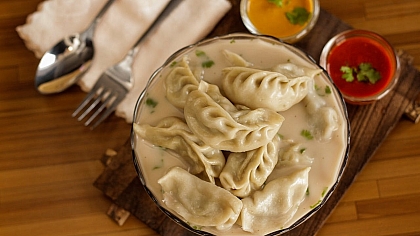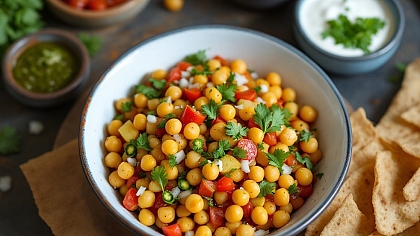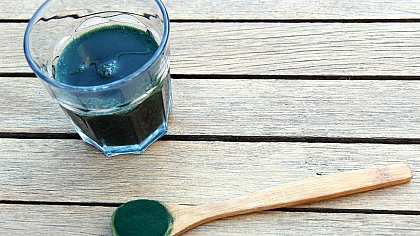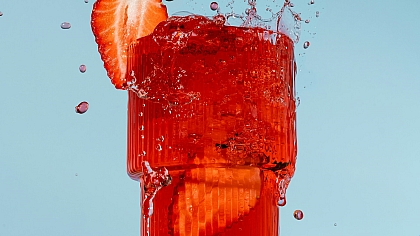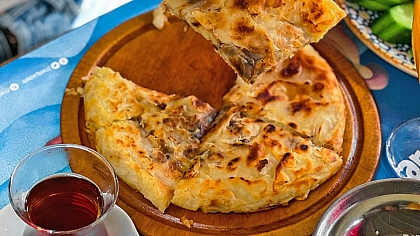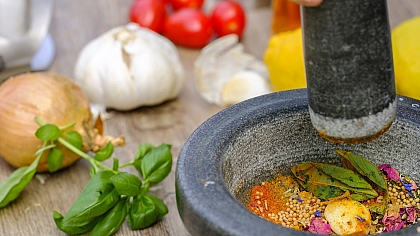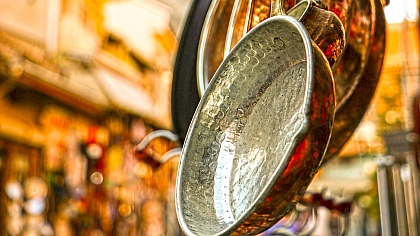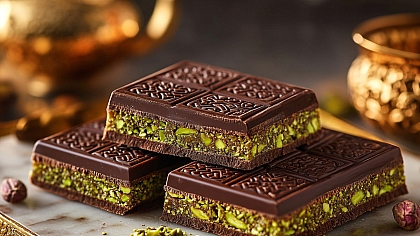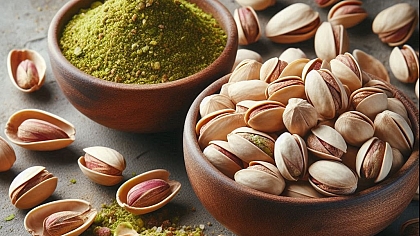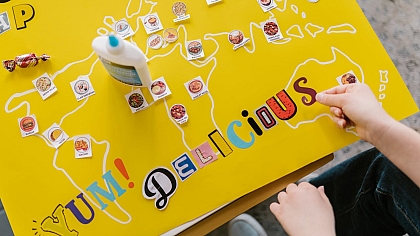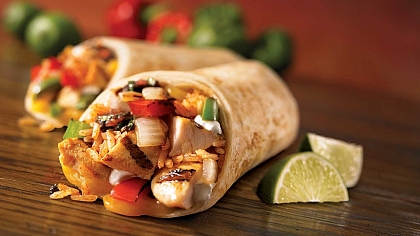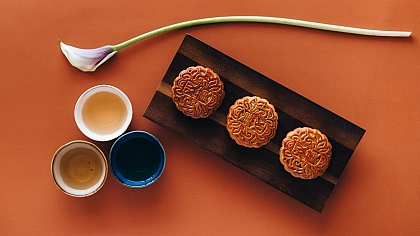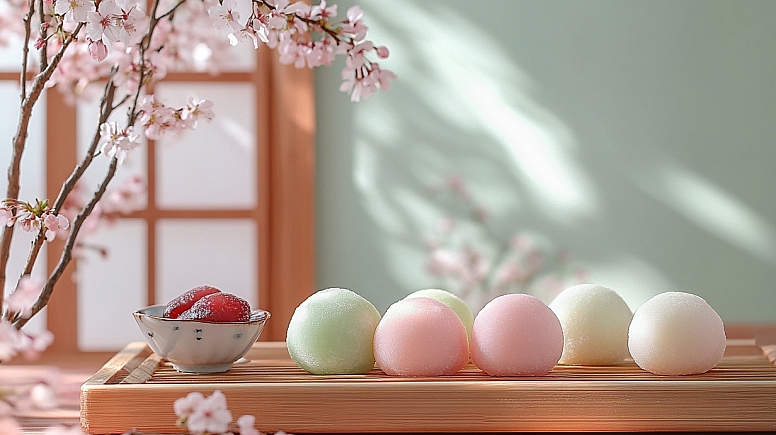
Mochi: Japan's Beloved Chewy Treat, Its Varieties & Global Trends
Mochi, a soft and chewy rice cake, is one of Japan’s most beloved and iconic foods. Made from glutinous rice that is pounded into a sticky, elastic dough, mochi is both a traditional treat and a versatile modern snack. While it is often enjoyed in sweet desserts, mochi also appears in savoury dishes, reflecting its adaptability and widespread appeal.
The word “mochi” is derived from the Japanese verb motsu, meaning “to hold” or “to carry,” symbolizing the food’s historical role as a source of sustenance and good luck. Over centuries, mochi has become an integral part of Japanese culture, celebrated for its unique texture, mild flavour, and the sense of community that surrounds its traditional preparation.
From centuries-old ceremonies to the trend of mochi ice cream, this humble rice cake has evolved significantly, crossing geographical borders and culinary genres. In this guide, we’ll explore the history, cultural importance, varieties, and modern adaptations of mochi, taking a journey into its rich tradition and expanding global influence. Whether you’re an experienced mochi lover or new to its charms, this guide will reveal the story and allure of this Japanese classic.
History and Cultural Significance of Mochi
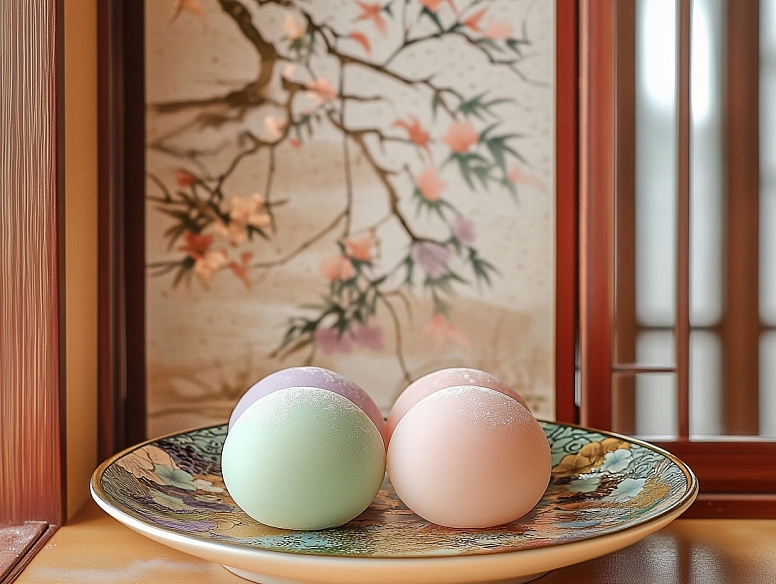
Mochi’s journey from a religious symbol to a global delicacy is a fascinating one, reflecting the deep-seated traditions and evolving tastes of Japanese culture. The process of making and consuming mochi has held symbolic meaning for centuries, particularly in the context of seasonal festivals, family gatherings, and religious rituals.
Ancient Origins and Religious Significance
Mochi’s history stretches back over a thousand years to Japan’s Heian period (794-1185), a time when rice cultivation became central to Japanese society. During this era, mochi was not just a food but a symbol of vitality, good fortune, and well-being. It was often used in early Shinto and Buddhist rituals as an offering. Since rice was considered a vital and life-sustaining resource, making and consuming mochi was seen as a way to honour its importance.
This cultural significance is especially evident in Japanese New Year celebrations. One notable tradition is Kagami Mochi, a decoration made of two stacked rounds of mochi, often topped with a small citrus fruit. Traditionally, Kagami Mochi is broken and eaten in early January.
Mochi and Japanese Festivals
Mochi’s role extends beyond New Year’s traditions to other festivals, where it often serves as both a celebratory food and a symbol of seasonal change. In autumn, for example, Tsukimi, or “moon-viewing,” is a popular festival that celebrates the beauty of the full moon. During Tsukimi, people offer special mochi called Tsukimi dango to honour the moon and pray for a bountiful harvest. These small, round rice cakes are arranged in pyramid-like stacks.
Another key event is Hinamatsuri, or the Doll Festival, which is celebrated on March 3 to wish for the health and happiness of young girls. Families display ornamental dolls and serve hishi mochi, a diamond-shaped, three-layered mochi in pink, white, and green. Each colour holds significance: pink represents protection from misfortune, white stands for purity, and green symbolizes health and vitality.
These examples highlight how deeply mochi is woven into the fabric of Japanese celebrations. Far beyond its role as a food, mochi has become a carrier of cultural values and a symbol of Japan’s connection to its agricultural roots, seasons, and spiritual beliefs.
The Art of Making Mochi
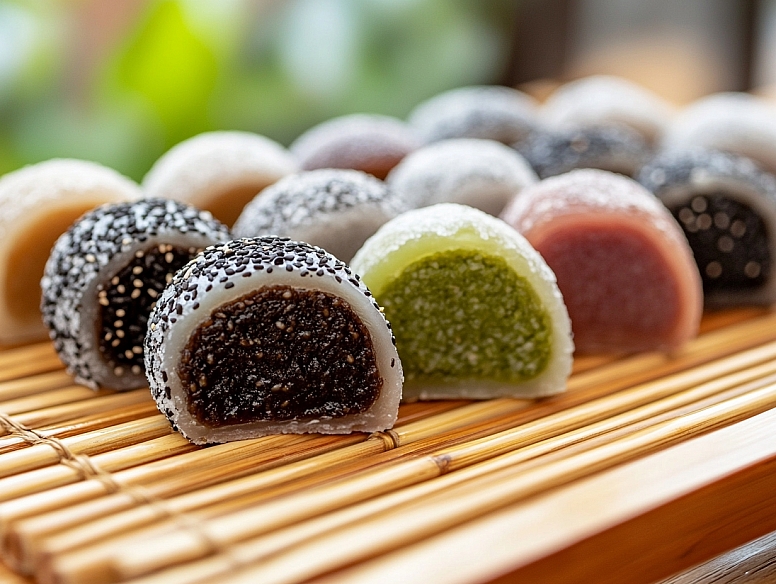
The process of making mochi is as unique as the rice cake itself, combining tradition, skill, and often a sense of community. Preparing mochi from scratch is not merely a culinary task—it’s a ritualistic art form that requires dedication and practice. While traditional methods are still practised in Japan, modern adaptations have made mochi more accessible to people worldwide. Let’s delve into both the time-honoured and contemporary approaches to making mochi.
Traditional Methods: The Mochitsuki Ceremony
The most iconic method of making mochi is mochitsuki, a labour-intensive ritual where glutinous rice, known as mochigome, is steamed and then pounded into a sticky, pliable dough. Mochitsuki typically takes place around the New Year, symbolizing community, strength, and unity. It’s often performed as a group activity, with participants each taking turns in the pounding process.
In a mochitsuki ceremony, the freshly steamed rice is first transferred into a large stone or wooden mortar called an usu. Two people usually work together to achieve the perfect mochi consistency: one person pounds the rice with a heavy wooden mallet, called a kine, while the other turns and wets the dough between each strike to prevent it from sticking and to keep it moist. This intense, rhythmic process is a delicate dance of timing, strength, and precision to ensure the mochi dough achieves the ideal smooth and elastic texture.
Once pounded, the mochi is quickly portioned out and shaped into smaller rounds. Some are left plain to symbolize purity, while others are filled with sweet red bean paste (anko) to make daifuku, a popular mochi treat. Mochitsuki brings families and communities together, fostering a sense of unity and tradition as participants celebrate the arrival of a new year with fresh mochi.
Modern Methods and Variations
While mochitsuki is still celebrated in Japan, modern life has made it challenging for many to perform the traditional ceremony. To adapt, many households and businesses have turned to contemporary methods that use mochi-making machines or blenders, which simplify and speed up the process while preserving the taste and texture of freshly pounded mochi.
Today, electric mochi machines can steam and pound the rice, replicating the mochitsuki process with minimal effort. This innovation allows people to make mochi at home without the labour-intensive pounding. Additionally, many recipes use mochi flour (also known as shiratamako or mochiko), which is made from ground glutinous rice. By simply mixing mochi flour with water and cooking it on the stove or in a microwave, people can make mochi quickly and easily, albeit with a slightly different texture from traditionally pounded rice.
The popularity of these modern methods has also led to more creativity in mochi-making, as people experiment with various flavours, fillings, and forms. Matcha (green tea) and kinako (roasted soybean flour) have become popular flavourings, while fillings range from fruit and custard to ice cream. These adaptations highlight mochi’s versatility and appeal across cultures, as both a traditional delicacy and a contemporary treat.
Types of Mochi and Popular Variants
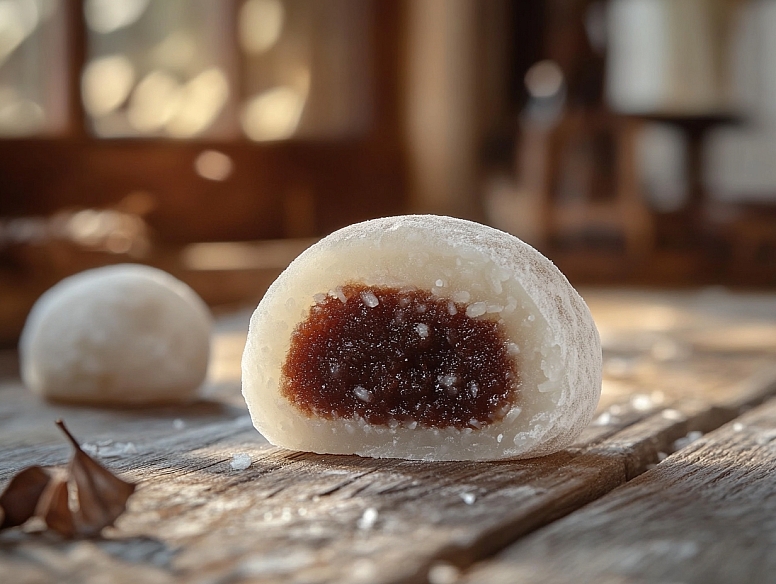
Mochi may be rooted in tradition, but its range of forms and flavours is vast, with each type showcasing unique textures and tastes. From classic, unadorned mochi to innovative regional and fusion varieties, mochi has evolved to suit a wide range of preferences.
Classic Plain Mochi
The simplest form of mochi is plain, unflavoured mochi, which typically has a smooth, stretchy texture and mild flavour. Plain mochi is often served grilled, boiled, or baked, and may be eaten alone or paired with seasonings like soy sauce and sugar. In Japan, plain mochi is a common ingredient in soups, particularly during the New Year, when it’s served in a special soup called ozoni. Ozoni recipes vary by region but typically include mochi, vegetables, and sometimes seafood or chicken, creating a warming and hearty dish that celebrates the season.
Another beloved way to enjoy plain mochi is grilled, which produces a slightly crispy exterior and chewy interior. Grilled mochi is often brushed with soy sauce and wrapped in nori (seaweed) to make isobeyaki, a popular savoury snack that combines umami flavours with the distinct chewiness of mochi.
Mochi Variants by Region
In addition to its classic form, mochi varies significantly by region, with each area of Japan producing its own speciality. Some regional types of mochi are unique in shape, texture, or ingredients, showcasing local culinary traditions.
-
Kusa Mochi (Yomogi Mochi): This green, herb-infused mochi is made with Japanese mugwort, or yomogi, which gives it a fresh, earthy flavour and vibrant green colour. Kusa mochi is often filled with sweet red bean paste and is a popular springtime treat, associated with growth and renewal.
-
Sakura Mochi: Popular in the Kanto and Kansai regions, sakura mochi is a spring delicacy made to celebrate the cherry blossom season. The pink-hued mochi is wrapped in a salted cherry leaf, which adds a hint of saltiness that balances the sweetness of the red bean filling. The combination of flavours and the delicate cherry blossom aroma make Sakura mochi a much-loved seasonal delight.
-
Hishi Mochi: This diamond-shaped, multi-layered mochi is associated with Hinamatsuri, or Doll Festival, celebrated on March 3. The mochi layers are pink, white, and green, and are an essential part of the Hinamatsuri festivities.
-
Warabi Mochi: Though it technically isn’t made from rice like traditional mochi, warabi mochi is a beloved dessert in Japan, especially during the hot summer months. Warabi mochi is made from bracken starch, giving it a jelly-like, translucent texture that’s softer and more delicate than typical mochi. It is usually served dusted with kinako (roasted soybean flour) and accompanied by a drizzle of kuromitsu, a dark, molasses-like syrup that adds sweetness and depth.
Warabi mochi’s light, refreshing qualities make it particularly popular in the Kansai region, where it is often sold by street vendors and enjoyed as a refreshing afternoon snack. Its delicate flavour pairs perfectly with the nutty kinako and rich kuromitsu, creating a dessert that’s simple yet full of complex flavours.
Modern and Fusion Mochi Varieties
In recent years, mochi has seen a wave of fusion adaptations and modern twists, blending traditional Japanese ingredients with global flavours. These innovations have expanded mochi’s appeal, especially outside Japan, where creative mochi products have gained significant popularity.
-
Mochi Ice Cream: Mochi ice cream has become one of the most popular forms of mochi internationally. Originating in the United States, it consists of a small ball of ice cream wrapped in a thin layer of mochi. With flavours ranging from classic matcha and red bean to chocolate, strawberry, and even exotic flavours like mango and lychee, mochi ice cream has become a favourite dessert worldwide.
-
Daifuku Mochi: Daifuku is one of the most beloved types of mochi and comes in many varieties. The classic form consists of a small, round mochi filled with sweetened red bean paste, but variations include fillings like white bean paste, fruit (such as strawberries), and even custard. Ichigo Daifuku, or strawberry-filled daifuku, is a springtime favourite, combining the freshness of ripe strawberries with the sweetness of mochi and anko.
-
Kinako Mochi and Zunda Mochi: These are variations where plain mochi is topped with different flavourings or sauces. Kinako mochi is sprinkled with roasted soybean flour and sugar, giving it a nutty flavour and a subtle sweetness. Zunda mochi, popular in the Tohoku region, is coated in a paste made from young soybeans, creating a green, earthy flavour profile.
Each of these variations highlights the versatility and adaptability of mochi, which can be enjoyed in countless ways, from traditional Japanese desserts to innovative fusion treats. Whether served plain, filled, or wrapped around ice cream, mochi’s appeal lies in its unique texture and adaptability, allowing it to capture the essence of both tradition and modernity.
Mochi in Popular Japanese Desserts
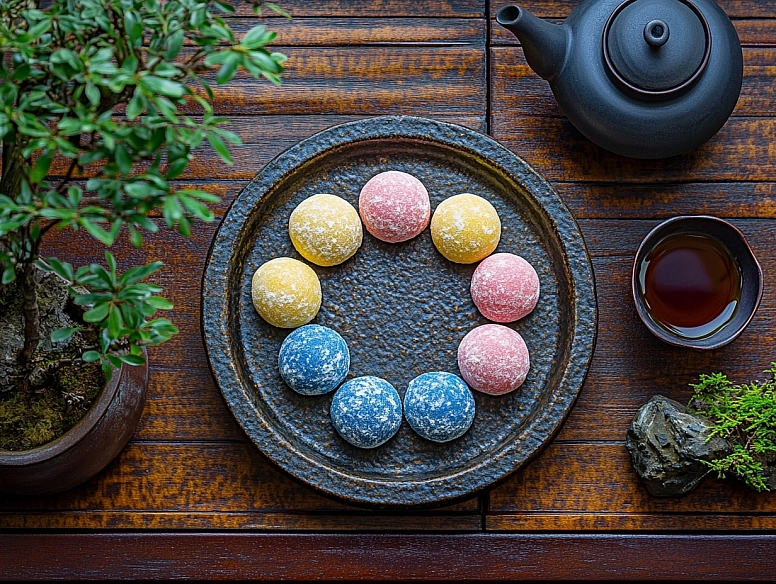
Mochi plays a starring role in many Japanese desserts, offering its signature chewy texture as a versatile base for both traditional and contemporary sweets. These desserts often combine mochi with fillings or toppings that enhance its naturally mild flavour, creating treats that are as visually appealing as they are delicious. Here are some of the most popular mochi-based desserts that showcase mochi's adaptability in the world of Japanese sweets.
Daifuku
One of the most iconic mochi desserts, daifuku is a soft, round mochi stuffed with sweet fillings, usually a paste made from red or white beans. The name “daifuku” translates to “great luck,” symbolizing good fortune and happiness. It’s one of the oldest and most loved mochi treats, with several popular varieties that offer different textures, flavours, and seasonal twists.
-
Anko Daifuku: This classic daifuku, the most traditional version, is filled with anko, or sweetened red bean paste. The soft, chewy mochi exterior balances the slightly grainy, sweet filling, making it a simple yet delightful treat.
-
Ichigo Daifuku: This version, which includes a whole strawberry inside the mochi along with the red bean paste, has become a springtime favourite in Japan. The juicy, tart flavour of the strawberry contrasts beautifully with the sweetness of the anko, while the mochi adds a chewy texture that brings all the flavours together.
-
Mame Daifuku: In this variation, whole or coarsely chopped soybeans are mixed into the mochi dough, adding a unique texture and mild, nutty flavour. The beans give this type of daifuku a more earthy, hearty taste that’s particularly popular among those who prefer a less sweet treat.
Mochi Ice Cream
Mochi ice cream has become one of the best-known forms of mochi outside Japan. This modern take on mochi involves wrapping a thin layer of mochi around a small scoop of ice cream, creating a frozen dessert that’s chewy on the outside and creamy on the inside. First popularized in the United States, mochi ice cream has become a global favourite, available in a wide range of flavours that combine Japanese tradition with Western-style ice cream.
Traditional Japanese flavours such as matcha (green tea), black sesame, and red bean are popular choices, but modern variations include flavours like vanilla, chocolate, mango, and strawberry to appeal to a wider audience. The cold, refreshing ice cream contrasts with the chewy mochi, making it an ideal treat for warm weather. The portability of mochi ice cream has also contributed to its popularity, as it’s often served in small, bite-sized portions that are easy to enjoy on the go.
Yatsuhashi Mochi
Originating from Kyoto, yatsuhashi is a type of mochi that comes in two main forms: baked or raw. The raw version, known as nama yatsuhashi, is a soft, triangular-shaped mochi that’s often flavoured with cinnamon and filled with red bean paste. This mochi is typically sold as a souvenir in Kyoto, beloved for its delicate cinnamon aroma and chewy texture. It’s a favourite among tourists looking for a sweet, unique taste of Japan’s cultural capital.
Ohagi and Botamochi
Ohagi and botamochi are similar mochi-based sweets with slight seasonal distinctions. Both are made by coating balls of glutinous rice with a layer of red bean paste, soybean flour, or sesame seeds. Ohagi is traditionally enjoyed during the autumn equinox, while botamochi is associated with the spring equinox. These seasonal treats celebrate the changing of the seasons and are enjoyed as part of family gatherings and offerings at Buddhist altars.
Both ohagi and botamochi have a distinct texture compared to other mochi desserts, as they are made with unpounded rice, resulting in a chewy, slightly grainy texture that contrasts with the smooth, sweet coating.
These mochi-based desserts highlight the versatility of mochi, showcasing its role in both traditional and contemporary Japanese sweets. Each dessert provides a unique experience, inviting people to savour the variety of flavours and textures mochi has to offer.
Health Benefits and Nutritional Profile of Mochi
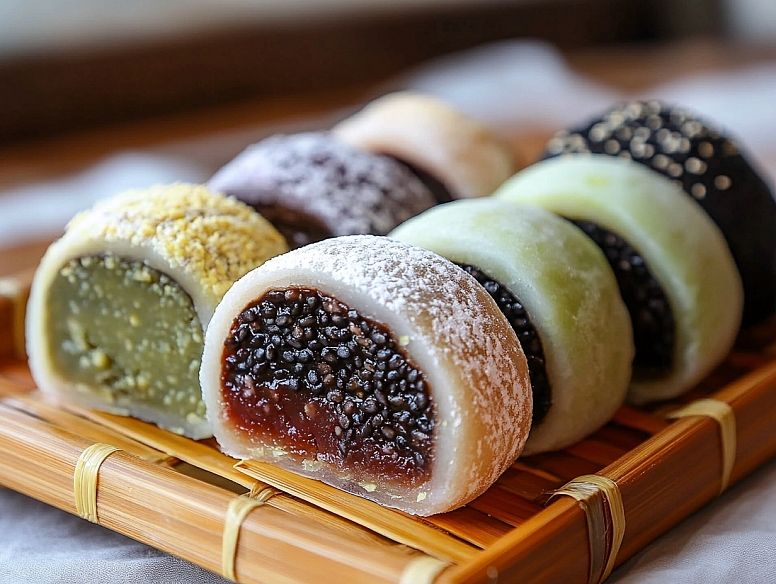
Mochi is not only beloved for its unique texture and flavour but also holds an interesting nutritional profile. Made from glutinous rice, mochi is dense in carbohydrates and provides quick energy. However, like many traditional foods, it’s best enjoyed in moderation.
Calories and Nutritional Facts
Mochi is relatively calorie-dense due to its high carbohydrate content, which is a result of its main ingredient: glutinous rice. Here is a general nutritional profile for a small 50-gram portion of plain mochi:
- Calories: Approximately 96 kcal
- Carbohydrates: 22 grams
- Protein: 1-2 grams
- Fat: 0-0.5 grams
- Fibre: Less than 1 gram
Due to the high amount of carbohydrates, mochi can be a quick source of energy, especially for those engaging in physical activity. This energy-boosting quality has made mochi a popular snack during festivals and celebrations. However, the low protein and fat content make it less balanced compared to other snacks, so it’s often best paired with other nutrient-dense foods.
Health Benefits of Mochi
While mochi is often enjoyed as a treat, it does offer several health-related benefits, especially when consumed as part of a balanced diet. Here are some of the key health aspects associated with mochi:
-
Good Source of Energy: The carbohydrates in mochi provide a fast energy source, which can be helpful for athletes, people with active lifestyles, or during busy festival days. Because of its carbohydrate content, mochi can be an ideal snack for energy replenishment.
-
Gluten-Free: Since mochi is made from glutinous rice, which is naturally gluten-free, it can be enjoyed by people with gluten sensitivities or celiac disease. The chewy texture of mochi offers a unique experience for those seeking gluten-free options, especially in desserts.
-
Low in Fat and Cholesterol: Plain mochi is low in fat and contains virtually no cholesterol, making it a lighter option compared to other desserts. However, different types of mochi (such as daifuku or mochi ice cream) may contain added fats and sugars due to their fillings or coatings, so it’s wise to be mindful of the specific type of mochi being consumed.
-
Rich in Manganese and Selenium: Glutinous rice, the primary ingredient in mochi, contains essential minerals such as manganese and selenium. Manganese supports bone health, metabolism, and the body’s antioxidant defences, while selenium helps protect cells from damage and plays a role in immune function.
Health Considerations and Potential Risks
While mochi has some beneficial properties, there are also a few health considerations to keep in mind:
-
Choking Hazard: Mochi’s chewy and sticky texture, which makes it unique and enjoyable, also poses a choking risk, especially for young children and the elderly. Every year, there are incidents in Japan where people choke on mochi, particularly during the New Year when mochi consumption is high. To prevent this, it’s essential to chew mochi thoroughly and cut it into smaller pieces if necessary.
-
High Glycemic Index: Mochi’s glutinous rice base has a high glycemic index, meaning it can cause a rapid spike in blood sugar levels. This may not be ideal for individuals with diabetes or those looking to maintain stable energy levels. Consuming mochi in moderation or pairing it with fibre-rich foods can help manage blood sugar levels.
-
Added Sugars in Filled Mochi: Many types of mochi, especially those with fillings like red bean paste, custard, or ice cream, can be high in added sugars. While these treats are delightful, the added sugar can increase calorie intake and affect blood sugar levels. Opting for plain mochi or homemade versions with reduced sugar fillings can be a healthier choice.
Balancing Mochi in a Healthy Diet
To enjoy mochi’s benefits while being mindful of its high carbohydrate content, consider these tips:
-
Pair with Protein or Fibre-Rich Foods: Eating mochi alongside foods high in protein or fibre can help balance blood sugar levels and increase satiety. Try pairing mochi with nuts, yoghurt, or fruit for a balanced snack.
-
Practice Portion Control: Given mochi’s density, it’s easy to consume a high number of calories in just a few pieces. Practising portion control and savouring mochi in small amounts can allow you to enjoy its unique taste without overindulging.
-
Explore Healthier Fillings and Toppings: Experimenting with healthier fillings, such as fruit or unsweetened anko, can make daifuku-style mochi a more nutritious option. Additionally, traditional toppings like kinako (roasted soybean flour) are naturally low in sugar and offer added protein.
Mochi can be enjoyed as part of a balanced diet, providing quick energy and a delightful texture. By understanding its nutritional profile and consuming it mindfully, you can savour the unique qualities of mochi while making choices that align with your health goals.
Mochi Around the World
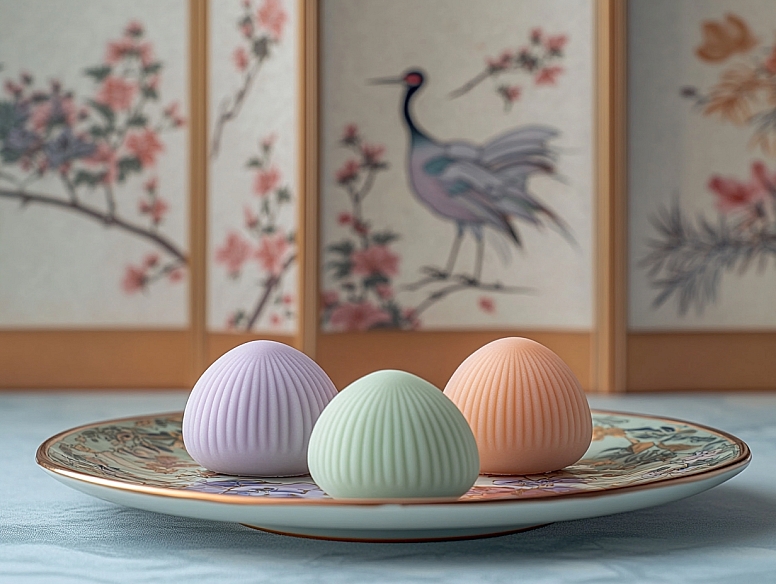
While mochi originated in Japan, its unique texture, versatility, and cultural appeal have led to its spread and adaptation in various parts of the world. As mochi has travelled, it has inspired local twists and fusion creations, blending traditional Japanese flavours with the culinary influences of other regions. Let’s explore how mochi has been embraced globally and the diverse ways it’s reimagined across different cultures.
Mochi in the United States: Mochi Ice Cream and Beyond
In the United States, mochi first gained popularity through restaurants and speciality stores, where it was initially introduced as part of Japanese cuisine. Over time, it became widely known and beloved, particularly in its frozen form—mochi ice cream. Japanese-American businesswoman Frances Hashimoto pioneered Mochi ice cream in the 1990s, who saw an opportunity to blend traditional mochi with a Western favourite, ice cream. The innovation of adding an ice cream filling to mochi skin created a portable, mess-free dessert with a chewy exterior and creamy interior, which quickly gained popularity.
Today, mochi ice cream can be found in mainstream grocery stores across the United States, with brands like My/Mochi offering flavours that go beyond traditional matcha and red bean to include Western flavours like vanilla, cookies and cream, and chocolate. Mochi doughnuts, another popular American creation, use mochi flour or dough to create chewy doughnuts that are lighter than traditional ones, often in ring shapes inspired by pon de ring, a Japanese mochi doughnut style. These doughnuts come in flavours like chocolate, matcha, ube, and strawberry, making them a favourite fusion dessert.
Mochi in Hawaii: Butter Mochi and Fusion Treats
Hawaii has a rich history of Japanese influence due to immigration in the early 20th century, and this has given rise to local mochi-inspired treats that blend Japanese and Hawaiian flavours. One of the most iconic Hawaiian mochi creations is butter mochi, a baked dessert made from glutinous rice flour, butter, sugar, and coconut milk. Unlike traditional Japanese mochi, butter mochi has a cake-like texture, with a golden, slightly crispy crust and a soft, chewy interior. This dessert highlights Hawaiian flavours, with the addition of coconut milk giving it a tropical twist.
In addition to butter mochi, Hawaiian cuisine offers a variety of mochi-inspired dishes, from mochi waffles to mochi pancakes, which use mochiko flour to create fluffy, slightly chewy versions of these breakfast classics. Local bakeries and cafes also frequently experiment with mochi-inspired flavours, incorporating taro, ube (purple yam), and tropical fruits like pineapple and mango.
Mochi in Southeast Asia
Southeast Asian countries, particularly those with strong culinary connections to rice-based dishes, have embraced mochi and incorporated it into local traditions. In the Philippines, for example, palitaw is a popular rice cake that resembles mochi, made from glutinous rice and topped with grated coconut, sugar, and sesame seeds. Although it’s not identical to Japanese mochi, the chewy texture and rice-based preparation make it a close relative.
Thailand also has its own version of mochi-like desserts. Khao tom mud is a sticky rice dessert wrapped in banana leaves and often filled with bananas or mung beans. This Southeast Asian interpretation highlights the versatility of glutinous rice and emphasizes tropical ingredients and flavours unique to the region.
Mochi in South America
Interestingly, mochi has found a place in Brazil due to Japanese immigration. Brazil is home to the largest Japanese population outside Japan, and Japanese cuisine has had a significant influence on Brazilian culinary culture. In Brazilian markets, it’s not uncommon to find mochi sold alongside traditional sweets, with some regional adaptations that incorporate Brazilian flavours like doce de leite (a caramel-like sweet milk) and açaí.
Brazilian-Japanese fusion desserts often use glutinous rice flour to replicate the chewy, satisfying texture of mochi. There are also adaptations where mochi is paired with tropical fruits or filled with unique South American ingredients, creating a Brazilian twist on the Japanese classic.
European Embrace of Mochi and Fusion Dishes
In Europe, mochi has started to appear in trendy dessert cafes, restaurants, and bakeries, especially as Japanese cuisine has become more popular across the continent. Mochi ice cream is a favourite in the UK, often found in speciality grocery stores and dessert bars. Additionally, cafes in cities like London and Paris have started to offer mochi-flavoured pastries, chocolates, and fusion desserts that highlight both traditional Japanese and local European ingredients.
Some European chefs have embraced the concept of mochi-based textures by experimenting with glutinous rice flour in unique ways. For example, in France, some pastry chefs have created “mochi éclairs” and “mochi macarons,” where glutinous rice flour is used to produce a unique texture that combines elements of both Japanese and French pastry traditions.
The Future of Mochi and Culinary Trends
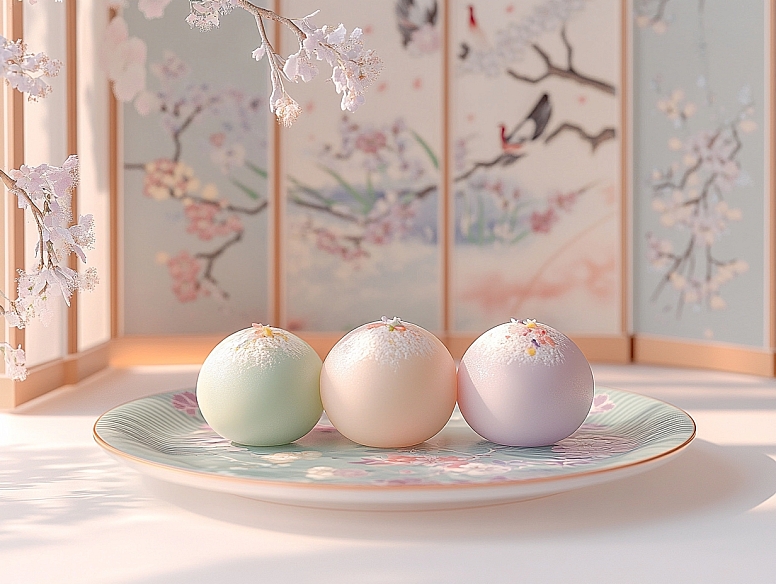
Mochi has seen a tremendous transformation from a ceremonial food in Japan to a global sensation enjoyed in countless variations. As the world’s culinary landscape continues to evolve, mochi’s versatility and unique texture make it well-positioned to inspire new food trends and innovations.
Mochi Fusion and Cross-Cultural Innovation
As global cuisine continues to embrace fusion, we can expect to see more cross-cultural innovations involving mochi. Mochi’s adaptable flavour profile and chewy texture make it an excellent canvas for experimenting with different ingredients, and chefs around the world are increasingly incorporating mochi into unexpected dishes. Some emerging trends include:
-
Savoury Mochi Dishes: While traditionally mochi is associated with sweets, chefs are beginning to explore its potential in savoury dishes. Mochi’s mild flavour allows it to absorb savoury sauces and seasonings, making it a candidate for fusion dishes like mochi dumplings, mochi-topped casseroles, or even mochi-based pasta. Some upscale restaurants have started featuring savoury mochi in appetizers or entrees, blending Japanese techniques with local culinary practices.
-
Mochi Street Food: As street food culture gains popularity globally, there is a growing demand for mochi-based snacks that are easy to eat on the go. Mochi skewers grilled with savoury sauces, mochi-stuffed buns, and even mochi-filled takoyaki (a savoury Japanese snack traditionally made with batter and octopus) are emerging in urban food markets around the world.
-
Mochi Pairings with Superfoods: With the rise of health-conscious dining, mochi is being combined with superfoods and nutrient-dense ingredients. Mochi infused with matcha, turmeric, spirulina, or chia seeds not only adds vibrant colours but also enhances the nutritional profile. These superfood-mochi combinations appeal to health-focused consumers looking for a nutrient-rich treat with a unique texture.
Creative Mochi Textures and Techniques
Innovations in food science and culinary techniques are enabling chefs to experiment with mochi in new and creative ways. By altering its texture, flavour, and presentation, mochi is being reimagined in ways that go beyond its traditional form. Here are a few trends we can expect to see:
-
Crispy Mochi and Mochi Frying: New preparations such as frying or baking mochi to achieve crispy textures are gaining traction. Crispy mochi cubes, mochi fries, and even mochi tempura are becoming popular in both fine dining and casual dining settings. These dishes preserve the chewy interior of mochi while creating a crispy outer layer, offering a contrast that appeals to adventurous eaters.
-
Layered Mochi Desserts: Similar to layered cakes or parfaits, layered mochi desserts are beginning to appear in trendy dessert cafes. These desserts feature layers of flavoured mochi, creams, fruit, and crunchy toppings, creating a multi-textured experience in each bite. This trend highlights mochi’s compatibility with other ingredients and brings it into the realm of Western-style dessert presentations.
-
Fermented Mochi Creations: As fermentation becomes more popular in culinary circles, mochi’s rice-based foundation makes it a candidate for fermented dishes. Some experimental chefs are exploring fermented mochi, which develops deeper flavours and can be incorporated into sauces or used as an ingredient in high-end Japanese cuisine. Mochi made with koji (the fungus used in soy sauce fermentation) is an example of a product that merges traditional Japanese fermentation techniques with modern culinary innovation.
Mochi in the Plant-Based and Gluten-Free Movements
With the rise of plant-based and gluten-free diets, mochi is uniquely positioned as an inclusive food that can cater to various dietary preferences. Made from rice and often vegan by nature, mochi offers a naturally gluten-free and dairy-free base for countless dishes and desserts, aligning with current consumer trends.
-
Vegan Mochi Ice Cream and Desserts: Many mochi ice creams and desserts are now being made with plant-based ice creams or milk alternatives, providing vegan options that maintain the creamy and chewy qualities people enjoy. As demand for plant-based foods grows, mochi will continue to gain popularity as a dairy-free dessert option that offers both novelty and indulgence.
-
Gluten-Free Mochi Pastries: Bakers are experimenting with mochiko (sweet rice flour) to create gluten-free pastries, from mochi muffins to mochi brownies. Mochiko’s chewy and satisfying texture provides a naturally gluten-free alternative to wheat flour, making it an ideal ingredient for pastries and bread that meet dietary needs without sacrificing taste or texture.
Sustainability and Ethical Sourcing in Mochi Production
As with many traditional foods, there is a growing awareness about the sourcing and production of mochi’s ingredients, particularly rice. Sustainable and ethical sourcing practices are becoming important to consumers who want to enjoy mochi responsibly. This focus on sustainability is leading some producers to emphasize organic rice, support small-scale farms, and promote eco-friendly packaging.
Additionally, some mochi producers are looking to minimize waste by using the entire rice crop or utilizing innovative techniques to extend mochi’s shelf life without preservatives. Such practices contribute to a more sustainable and conscientious approach to mochi production, meeting consumer demand for ethical food choices.
Mochi as an International Staple
As mochi continues to find a place in global cuisine, it’s likely to become an international staple, not just as a novelty but as a versatile ingredient used widely in everyday cooking. Mochi flour is increasingly available in supermarkets outside Japan, and mochi-inspired snacks and treats are now familiar items on international dessert menus. This mainstream adoption suggests that mochi could eventually become a pantry staple, like pasta or tortillas, offering a unique option for home cooks seeking a different texture and flavour experience.
The future of mochi is bright, with exciting possibilities for innovation and cultural exchange. As mochi continues to evolve beyond its traditional Japanese roots, it has the potential to inspire global culinary creativity, bridging cultures and providing delicious experiences across the world. This enduring delicacy reminds us that food, like culture, can be both timeless and adaptable, celebrating tradition while embracing change.

